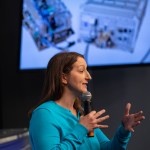
NASA Technologies Aim to Solve Housekeeping’s Biggest Issue – Dust

NASA Technologies Aim to Solve Housekeeping’s Biggest Issue – Dust

If you thought the dust bunnies under your sofa were an issue, imagine trying to combat dust on the Moon. Dust is a significant challenge for astronauts living and working on the lunar surface. So, NASA is developing technologies that mitigate dust buildup enabling a safer, sustainable presence on the Moon.
A flight test aboard a suborbital rocket system that will simulate lunar gravity is the next step in understanding how dust mitigation technologies can successfully address this challenge. During the flight test with Blue Origin, seven technologies developed by NASA’s Game Changing Development program within the agency’s Space Technology Mission Directorate will study regolith mechanics and lunar dust transport in a simulated lunar gravity environment.
Why Is Lunar Dust a Problem?
With essentially no atmosphere, dust gets lofted, or lifted by the surface, by a spacecraft’s plumes as it lands on the lunar surface. But it can also be lofted through electrostatic charges. Lunar dust is electrostatic and ferromagnetic, meaning it adheres to anything that carries a charge.
Kristen John, NASA’s Lunar Surface Innovation Initiative technical integration lead at Johnson Space Center said, “The fine grain nature of dust contains particles that are smaller than the human eye can see, which can make a contaminated surface appear to look clean.”
Although lunar dust can appear smooth with a powder like finish, its particles actually have a jagged shape. Lunar dust can scratch everything from a spacesuit to human lungs. Dust can also prevent hardware from surviving the lunar night when it accumulates on solar panels causing a reduction in available power. A buildup of dust coats thermal radiators, increasing the temperature of the equipment. Lunar dust can also accumulate on windows, camera lenses, and visors leading to obscured vision.
Dirty Moon? Clean It Up.
The projects being tested on the lunar gravity flight with Blue Origin include ClothBot, Electrostatic Dust Lofting (EDL), and Hermes Lunar-G.
ClothBot
When future astronauts perform extra-vehicular activities on the lunar surface they could bring dust into pressurized, habitable areas. The goal of the ClothBot experiment is to mimic and measure the transport of lunar dust as releases from a small patch of spacesuit fabric. When agitated by pre-programmed motions, the compact robot can simulate “doffing,” the movement that occurs when removing a spacesuit. A laser-illuminated imaging system will capture the dust flow in real-time, while sensors record the size and number of particles traveling through the space. This data will be used to understand dust generation rates inside a lander or airlock from extra-vehicular activity and refine models of lunar dust transport for future lunar and potential Martian missions.
Electrostatic Dust Lofting
This technology will examine the lofting of lunar dust when electrostatic charging occurs after exposure to ultraviolet light. The EDL’s camera with associated lights will record and illuminate for the duration of the flight. During the lunar gravity phase of the flight, a vacuum door containing the dust sample will release and the ultraviolet light source will illuminate the substance, charging the grains until they electrostatically repel one another and become lofted. The lofted dust will pass through a sheet laser as it rises up from the surface. When the lunar gravity phase ends, the ultraviolet light source disables, and the camera will continue recording until the end of the flight. This data will inform dust mitigation modeling efforts for future Moon missions.
Hermes Lunar-G
NASA partnered with Texas A&M and Texas Space Technology Applications and Research (T STAR) to develop Hermes Lunar-G, technology that utilizes flight-proven hardware to conduct experiments with regolith simulants. Hermes was previously a facility on the International Space Station. Hermes Lunar-G repurposed Hermes hardware to study lunar regolith simulants. The Hermes Lunar-G technology uses four canisters to compress the simulants during flight, takeoff, and landing. When the technology is in lunar gravity, it will decompress the contents of the canisters while high-speed imagery and sensors capture data. Results of this experiment will provide information on regolith mechanics that can be used in a variety of computational models. The results of Hermes Lunar-G will be compared to microgravity data from the space station as well as similar data acquired from parabolic flights for lunar and microgravity flight profiles.
The Future of Dust Mitigation
As a primary challenge of lunar exploration, dust mitigation influences several NASA technology developments. Capabilities from In-Situ Resource Utilization to surface power and mobility, rely on some form of dust mitigation, making it a cross-cutting area.
Learning some of the fundamental properties of how lunar dust behaves and how lunar dust impacts systems has implications far beyond dust mitigation and environments. Advancing our understanding of the behavior of lunar dust and advancing our dust mitigation technologies benefits most capabilities planned for use on the lunar surface.”

Kristen John
NASA’s Lunar Surface Innovation Initiative Technical Integration Lead
Engineering teams perform a variety of tests to mitigate dust, ensuring it doesn’t cause damage to hardware that goes to the Moon. NASA’s Game Changing Development program, created a reference guide for lunar dust mitigation to help engineers build hardware destined for the lunar surface.
NASA’s Flight Opportunities program funded the Blue Origin flight test as well as the vehicle capability enhancements to enable the simulation of lunar gravity during suborbital rocket flight for the first time. The payloads are managed under NASA’s Game Changing Development program within the agency’s Space Technology Mission Directorate.
To learn more visit: https://www.nasa.gov/stmd-game-changing-development/






